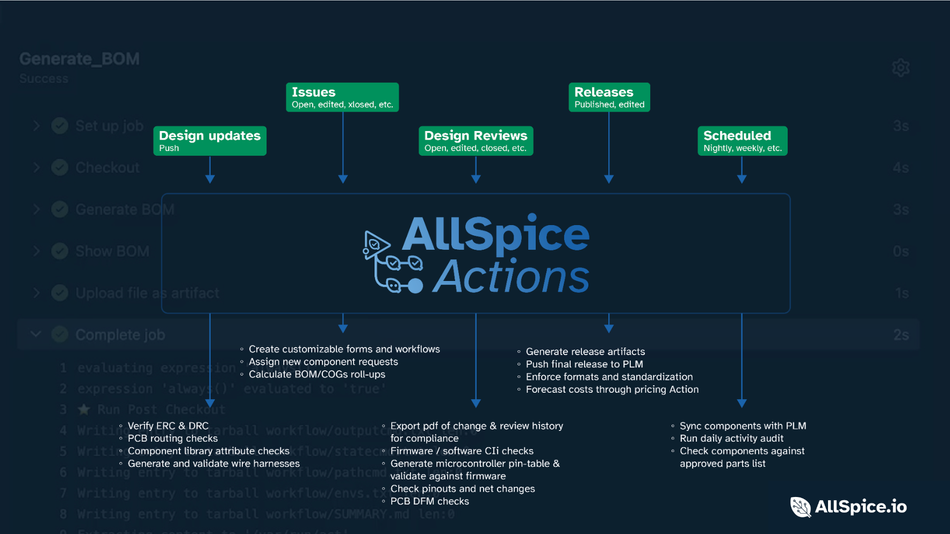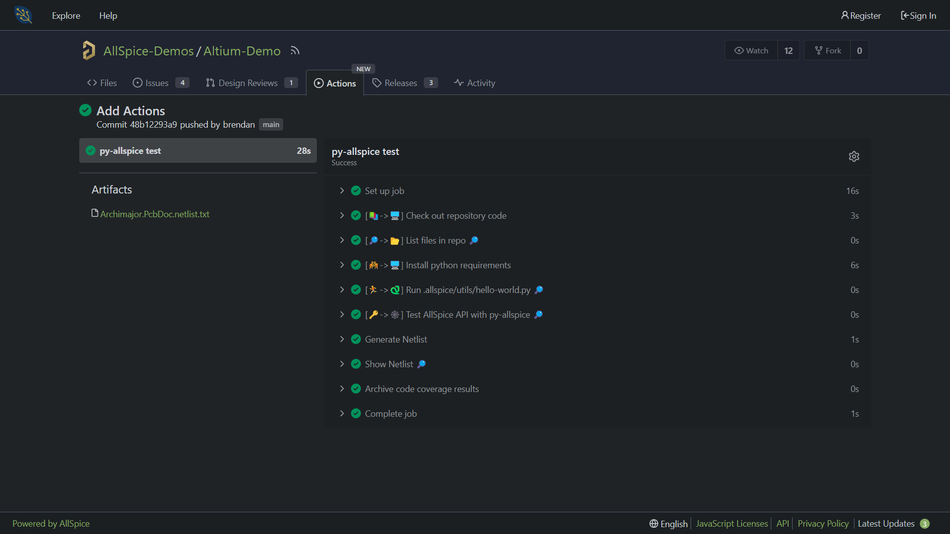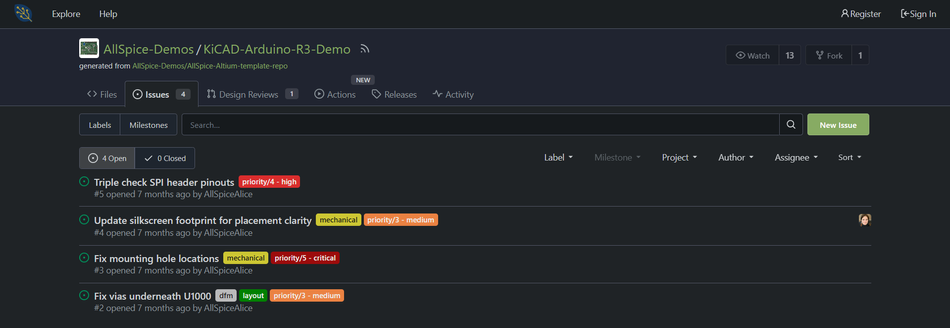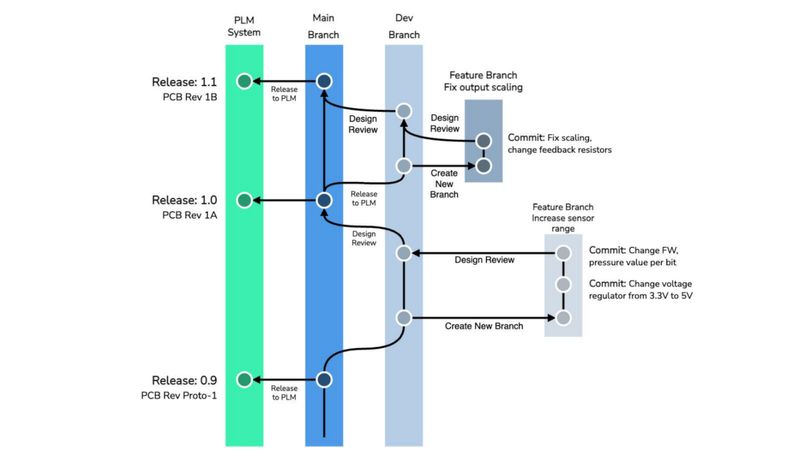Learning from Git: The Role of Software Practices in Hardware Development
AllSpice is a Git-based collaboration platform that transforms hardware development by streamlining project workflows, enhancing design precision, and reducing time to market through established software engineering practices such as Agile and CI/CD.
Introduction
In the fast-paced world of technology, the ability to adapt and learn from various disciplines is invaluable. One of the most influential tools in software development is Git, a version control system that has revolutionized how engineering teams collaborate and manage code changes. While Git is traditionally associated with software, its principles and practices offer significant advantages when applied to hardware development, a field where managing complex workflows and collaboration are equally critical.
Hardware development, like software, involves intricate design and testing phases, but it faces unique challenges due to its physical componentry and integration needs. By examining and adapting the methodologies used in Git, hardware engineers can potentially streamline their workflows and enhance productivity. This article explores the role of software practices, specifically those associated with Git, in transforming hardware development processes facilitated by platforms like AllSpice that integrate these methodologies seamlessly into hardware projects.
This article is part of The Future of Hardware Development, a series featuring insights into how cutting-edge collaborative platforms transform traditional hardware development workflows, integrating advanced version control systems and paving the way for more efficient, error-free project management.
Bringing agility to hardware development
Agile methodologies, traditionally rooted in software development, emphasize flexibility, efficiency, and continuous improvement through iterative development and frequent reassessment. These principles can also be beneficial in hardware development, which often suffers from long development cycles and complex integration challenges.
Adapting Agile practices for hardware development
Incorporating Agile, a responsive and adaptive approach to project management, into hardware development involves breaking down large projects into smaller, manageable increments that are continuously evaluated. This method allows teams to focus on delivering functional segments of a product regularly, facilitating early detection of design flaws and integration issues. Moreover, Agile encourages cross-functional collaboration, ensuring that mechanical, electrical, and software components are aligned and integrated from the early stages of development.
Implementing CI/CD in hardware development
The incorporation of software methodologies such as Continuous Integration (CI) and Continuous Delivery (CD) into hardware development represents a significant shift towards more dynamic and responsive design processes. Originally pioneered in the software industry to facilitate rapid development cycles and enhance product quality, these methodologies are now being adapted to meet the unique challenges of hardware engineering.
CI is a practice where developers frequently integrate their changes into a shared repository several times a day. Each integration can then be verified by an automated build and automated tests. While this concept is straightforward in software, applying it to hardware development involves adapting these principles to accommodate physical products. Sophisticated automated testing architecture is required that can immediately test hardware components as they are designed or modified. These systems might include simulation software that can predict how a change in one component affects others or physical testing rigs that automatically run tests on actual hardware pieces.
CI in hardware involves the regular integration of component designs and sub-assemblies into a central repository where automated builds and tests ensure early detection of potential integration issues. This approach reduces the risks associated with integrating hardware components late in the development cycle, thus minimizing costly delays and errors.
CD extends CI by ensuring that hardware designs can be released into production at any time. Establishing routines where hardware designs are regularly updated and integrated into the main project repository. This practice helps in identifying integration issues early, preventing the last-minute surprises that can delay product releases. It streamlines the path from design to manufacture, allowing teams to quickly respond to market changes and customer feedback.
Building on the foundation of Agile and CI/CD, the adoption of Git practices in hardware development can further streamline processes. Git, with its robust version control system, provides the tools to manage complex design files much like software code is managed.
Core concepts of Git relevant to hardware development
Git has fundamentally transformed software development practices, offering a robust framework for managing complex projects through its decentralized approach and powerful tools for collaboration. The principles that make Git effective for software are equally applicable to hardware development, where managing iterations, collaboration, and integration are paramount.
By dissecting the core concepts of Git, we can uncover how these can be translated into the hardware development process, offering a systematic approach to managing the complexities inherent in physical product design and production.
Version control
Git's primary function is to serve as a version control system, allowing developers to track changes over time. This function is crucial in hardware development, where each component's design might evolve through multiple iterations. Implementing version control allows engineers to maintain a comprehensive history of changes, revert to previous versions when needed, and understand the evolution of each component.
Branching and merging
Branching is one of Git’s standout features, permitting multiple developers to work on different features simultaneously without affecting the main project. This methodology can be incredibly beneficial in a multidisciplinary hardware project where electrical, mechanical, and software teams need to develop parts independently before integrating them into a single product. Merging then allows these independent lines of development to come together in a controlled and recorded manner, ensuring that all contributions are aligned and functional.
Commits
In Git, commits act as checkpoints where individual changes to files are saved. Each commit includes a message describing the change, providing a clear audit trail of who did what and why. For hardware development, this means every change to the design files, from a small modification in a component to a major architectural overhaul, can be tracked and documented. This level of detail is invaluable, particularly for complex projects requiring certification or regulatory compliance.
By adopting these core Git concepts, hardware development teams can achieve greater control over project complexities, improve the accuracy of their documentation, and enhance collaboration across different areas of expertise, all of which are essential for successful hardware innovation.
Check out an eBook by AllSpice about mastering Git for hardware engineering: The Git for Hardware Guide
Benefits for the hardware industry
The adaptation of software practices such as Agile and CI/CD into hardware development brings numerous tangible benefits that significantly elevate industry standards.
Reduced Time to Market: By enabling more frequent integration and quicker feedback loops, CI/CD practices help hardware teams accelerate their design and development cycles. This rapid iteration capability allows companies to bring products to market faster than ever before, responding swiftly to consumer demands and technological advancements.
Enhanced Product Quality: Continuous testing and integration ensure that any discrepancies or defects are identified and addressed early in the development process. This not only improves the reliability of the final product but also boosts consumer trust and satisfaction.
Cost Efficiency: Streamlined workflows and automated processes reduce the need for repeated manual interventions, cutting down on labor costs and minimizing the risk of expensive errors. These efficiencies make the overall development process more cost-effective, allowing companies to allocate resources more strategically.
Environmental Sustainability: Efficient use of resources and reduction in waste are key benefits of integrating CI/CD into hardware development. These practices promote sustainability by minimizing the ecological footprint of manufacturing processes, in line with global efforts towards environmental conservation.
These benefits clearly illustrate how incorporating software methodologies into hardware development can lead to smarter, faster, and more responsible manufacturing practices.
AllSpice's role in modernizing hardware development
AllSpice is a Git-based collaboration platform that leverages the principles of software development to transform hardware engineering practices. By integrating CI/CD into the hardware development process, AllSpice enhances operational efficiency and significantly reduces environmental impact. Now, let's look at some of the practical benefits of using the AllSpice platform.
Automated workflows
AllSpice Actions enhances Agile workflows in hardware development by introducing automated tasks and workflows that are seamlessly integrated into the Agile sprint cycles. By automating design checks, validation processes, and documentation updates, teams can focus more on iterative design improvements and less on repetitive tasks. This integration allows for faster sprint cycles, improved team collaboration, and real-time feedback, which are crucial for Agile environments where quick pivoting and iterative updates are standard.
CI/CD with AllSpice actions
AllSpice Actions is a feature designed to foster a robust CI environment specifically tailored for hardware development. With features like automated Bill of Materials (BOM) generation, netlist analysis checks, and design review audit logs, hardware engineers can ensure that every design iteration is tested and validated from the start of the development process. This reduces the integration issues typically faced at the later stages of hardware design, ensuring a smoother, more reliable integration of new design changes.
In hardware engineering, where changes can be costly and time-consuming, CD is facilitated by AllSpice Actions through automated workflows that streamline the release process. From automated compliance reports to final release packaging, AllSpice ensures that each design iteration is not only tested but also ready for deployment at any stage. This capability is crucial for maintaining a competitive edge by enabling faster market entry of new and updated products.
Error detection and resolution
Early and immediate error detection is a core requirement of effective CI/CD pipelines. With AllSpice, engineers can integrate early error detection mechanisms directly into the design process, catching issues like incomplete libraries or invalid part numbers as soon as they arise. This immediate feedback loop helps in the quick resolution of issues, significantly reducing downtime and backtracking in design workflows, which is especially beneficial in an Agile setup.
Standardization and compliance
Maintaining standardization across projects is vital for scaling operations in hardware development. AllSpice supports this by allowing teams to define standard workflow templates and checklists that ensure compliance with internal and industry standards. This standardization helps reduce variability in the outcomes and simplifies the onboarding process for new team members, aligning with the principles of both Agile and CI/CD methodologies.
Efficiency and productivity
By reducing manual checks and fostering an environment of automated validations and checks, AllSpice notably increases engineering productivity. Teams can allocate more resources towards innovation and development rather than getting bogged down by routine checks and validations. This efficiency is a direct benefit of integrating CI/CD principles, which focus on automating as much of the software development process as possible to increase release rates and improve product quality.
Visit AllSpice’s official website today to explore how the platform can streamline your hardware development process.
Conclusion
Overcoming challenges in hardware engineering requires a committed approach to adopting new technologies and practices. By leveraging platforms like AllSpice and adopting a gradual, informed strategy to integration, hardware development teams can reap the substantial benefits of software methodologies, making way for more efficient, agile, and sustainable product development.
References
[1] Jamie. CI/CD's impact on hardware development life cycles [Internet]. AllSpice. Available from: https://allspice.io/post/ci-cds-impact-on-hardware-development-life-cycles
[2] Jamie. Benefits of Git for hardware: Branches & branch protections [Internet]. AllSpice. Available from: https://allspice.io/post/benefits-of-git-for-hardware-branches-branch-protections
Download the eBook, 'Implementing Git in 30 Days,' to start transforming your hardware development process today.



